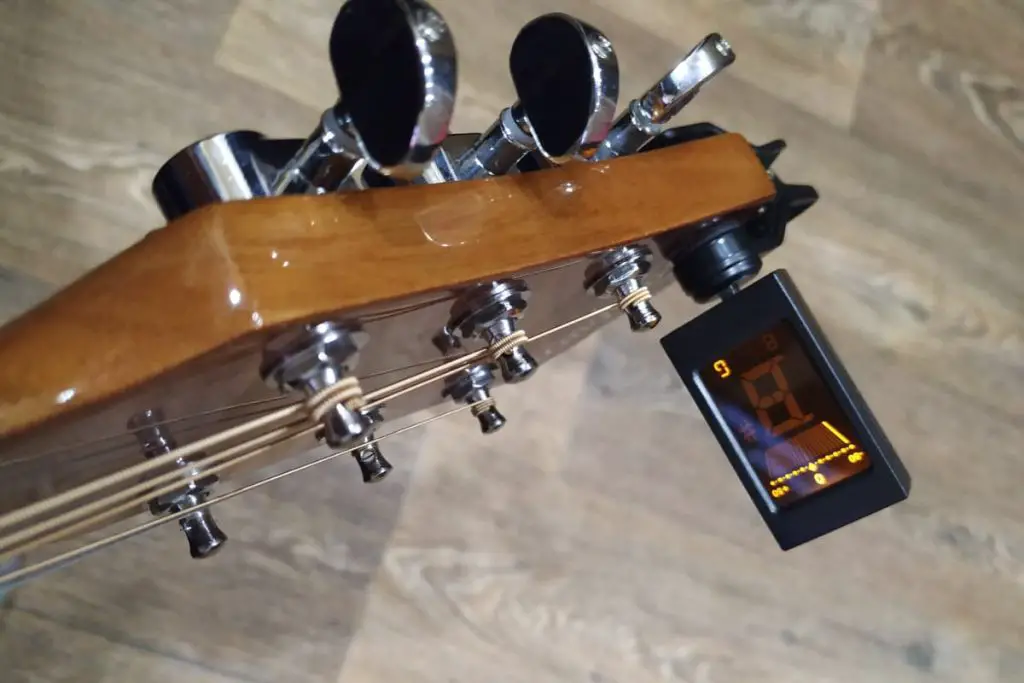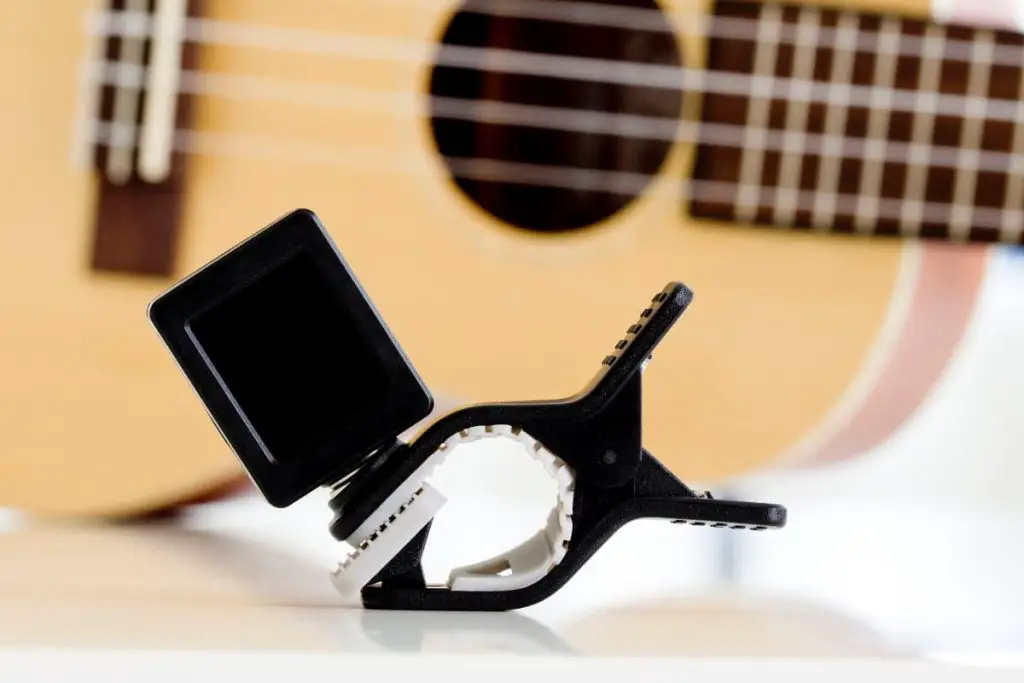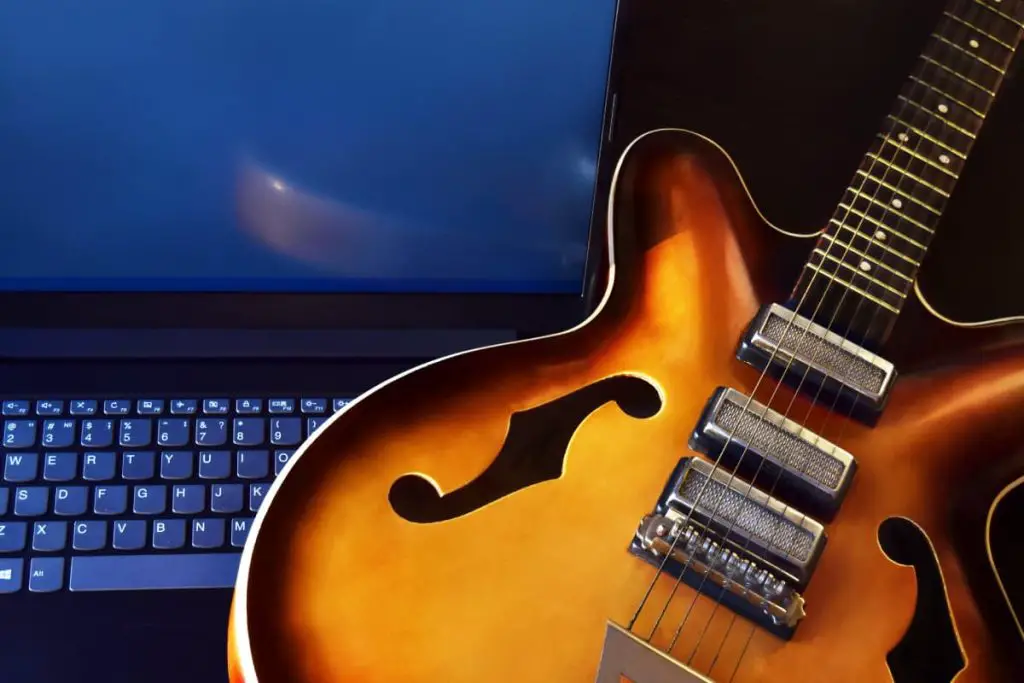Have you ever heard somebody play an out-of-tune guitar? It certainly isn’t the same crisp, rockin’ sound of one that is perfectly and harmoniously tuned. Tuning an electric guitar can be done in several ways, both with or without an amplifier or any equipment at all!
An amplifier is not necessary to tune an electric guitar. Instead, tuning can be done through tuning pedals, clips, online apps, or even by ear. This is because amplifiers are primarily used to project sound, usually for music concerts and events, not for tuning instruments.
So if an amp isn’t available when your guitar needs tuning, don’t fret! This article will provide all the information you need to learn the basics of guitar tuning with and without equipment. I’ll also discuss a few of the different devices and tuning methods on the market.
If you want to find out what my recommended guitar gear is, then here is what I recommend on Amazon:
- Fender Cutaway Acoustic-Electric Guitar Bundle (MY FAVORITE GUITAR)
- Snark SN-8 Super Tight All Instrument Tuner (Easiest Tuner I’ve Used😏)
- 6 String Acoustic Guitar Capo (Best CAPO for quick changes)
- Dunlop Max Grip 1.0mm Nylon Picks (Thick Guitar Pick So You Don’t Lose Grip!)
- Universal Guitar Stand (Cheap & Minimalist Guitar Stand I Recommend)
- Levy’s 2″ Wide Quick Adjust Guitar Strap (Best Guitar Strap For Any Level)

Understand Standard and Alternate Guitar Tuning
Before fully grasping how to tune your guitar correctly, it’s essential to understand the difference between standard and alternate types of tuning. Each has its merits but ultimately, the choice comes down to preference and accuracy. Generally if you’re looking for accuracy, the best choice is usually equipment-based tuning.
Since guitars only have six strings (unlike a piano with a range of close to ninety keys), standard tuning is most often in the keys of E-A-D-G-B-E. The low E is the thickest string on the guitar or the topmost string when holding the instrument in playing position.
Sometimes, musicians choose alternate tuning keys to create different-sounding songs. For example, a common alternate tuning scale is D-A-D-G-A-D (dadgad).
Led Zeppelin’s unique tune Black Mountainside is a popular song that uses this scale. Joni Mitchell, too, used Dadgad in her music. You can check it out on this video:
Choosing to tune your guitar in standard or alternate scales is a personal decision based on how you want your music to sound. Of course, this guide will teach you how to change the sound of your instrument any time you want to mix things up.
1. Tune Your Guitar With Equipment
Two well-known devices used to tune an electric guitar are tuning clips and tuning pedals. Each accomplishes the same goal with relatively high accuracy but in different ways. Musicians use clip-on and pedal tuners in several types of environments.
Tuning Clip (Clip-On Guitar Tuner)
A tuning clip is essentially a tuner that gets clipped onto the headstock of a guitar (the piece with the tuning pegs on it). When a string is played, the vibration of the note on the guitar’s body gets converted into an electric signal through the tuner.
A small screen on the clip will display whether the note is in tune, sharp (a little higher), or flat (a little lower) than it should be.
The display varies in appearance depending on the brand of tuner purchased. Some tuning clips will have a screen with red and green lights to signal a guitar string that is not tuned (the green light will flash when the string is tuned).
Others will use an arrow or notch that points to green, yellow, or red colors to help guide you to the correct note.
Strings are typically tuned individually by either plucking the string and tightening the tuning peg to give the string a higher pitch or loosening the peg to lower the pitch.
Tuning clips are top-rated because they are discreet and lightweight. Some can be left on the headstock to ensure the instrument is in tune throughout its use.
They’re also handy because they work through vibrations, thus an excellent tuner for loud environments where it may be difficult for the device to hear the instrument’s sound.

Here are some of the best tuning clips to buy on Amazon along with their links:
- Snark SN5X Clip-On Tuner for Guitar, Bass & Violin: This clip-on tuner has a bright and easy-to-read display, can be used on guitar, bass, and violin, and features a compact design.
- KLIQ UberTuner Clip-On Tuner: This tuner features a fast and accurate response time, a large display, and a wide tuning range. It also has a sturdy and durable construction.
- D’Addario NS Micro Sound Hole Tuner: This tuner clips onto the sound hole of the guitar and features a highly sensitive piezo transducer for accurate tuning. It has a discreet and low-profile design.
- Peterson StroboClip HD Clip-On Tuner: This tuner features high-definition tuning accuracy and a bright and clear display. It can be used on a wide range of instruments and has a durable and reliable construction.
- TC Electronic PolyTune Clip: This tuner features a polyphonic tuning mode, allowing you to tune all strings at once, as well as a strobe tuning mode for more precise tuning. It has a compact and ergonomic design.
Tuning Pedals
Tuning pedals are another simple and popular tool for guitar tuning. Essentially, the guitar is plugged into the tuning pedal with an input cable, and the pedal is plugged into an energy source of its own.
The exact process is then completed: after plugging in the guitar, each string should be played independently and tuning pegs adjusted (according to the display on the pedal’s screen).
The difference is that while tuning clips use the vibration of the guitar’s body to tune the instrument, the pedal uses the electrical signal from the guitar’s input to identify the string’s pitch.
Since these two methods are so different, you might wonder how they accurately measure the guitar strings’ tune.
Electric guitars are built with magnetic devices called pick-ups, which sit beneath the strings on the guitar’s body and capture the instrument’s vibrations. The vibrations are then directed through the input cable as electrical signals and are translated into pitches based on hertz.
A pitch refers to how fast or slow a sound is vibrating. The faster the vibration, the higher the frequency. If the vibration is slow, the frequency is low.
Frequencies and pitches are measured in hertz, and both tuning clips and pedals use hertz as a measurement to identify the guitar’s tune. That’s how both types of tuners work similarly and maintain consistent results.
Hertz
Most instruments are tuned using standard tuning as mentioned previously (E-A-D-G-B-E). In measurement terms, this means that when plucked, each note vibrates at a particular frequency (or speed), producing a different pitch based on how tight or loose the string is wound.
Based on standard tuning, the low E string will vibrate at 82 hertz per second and the highest E at 330 hertz per second. For instruments to sound well together, they should be consistently tuned so that the A above middle C on a musical scale vibrates at 440 hertz per second. This produces the standard guitar tuning pitches.
Having a standardardization of hertz is important for musicians that play in bands. When bands play multiple instruments together, all of their instruments should be tuned according to the standard.
2. Best Guitar Tuning Apps, Software and Websites
If tuning devices aren’t available, the most accessible way to tune your guitar is through a tuning application or website.

Here are some of the best guitar tuning apps, software, and websites, along with their external links:
- GuitarTuna (https://yousician.com/guitartuna): This app is available for free on both Android and iOS and has a simple, user-friendly interface. It features a wide range of tuning options, including standard and alternate tunings, and can also be used to tune bass, ukulele, and other stringed instruments.
- Fender Tune (https://www.fender.com/apps/fender-tune): This app is also free and available on both Android and iOS devices. It offers a range of tuning modes and a variety of alternate tunings, as well as tools for chord diagrams and scale charts.
- Pro Guitar Tuner (https://www.proguitartuner.com/): This website offers a free online guitar tuner that is easy to use and accurate. It can also be used to tune other stringed instruments, such as bass and ukulele.
- PitchLab Guitar Tuner (https://play.google.com/store/apps/details?id=com.musician.tuner): This app is available for Android devices and offers a variety of tuning modes, including standard and alternate tunings. It also includes a feature for tuning by ear and a metronome.
- Tune by Ear (https://www.tunebyear.com/): This website offers a free ear training tool that can help you develop your sense of pitch and learn to tune your guitar by ear.
- GuitarTapp PRO (https://www.ultimate-guitar.com/guitartapp-pro): This app is available for iOS devices and offers a variety of tuning modes and a chord library. It also includes tools for creating and editing tablature.
Another simple method is to use a tuned piano or guitar as a reference point. Play the key that you want to hear, and try to match your desired string to the sound of the key.
Both of these methods require the presence of another instrument and a good ear for sound. Luckily anyone can develop a good ear with enough practice and dedication.
Suppose you’ve got no tuning devices, no reference points, and an untuned guitar. Getting your instrument in good shape is still possible with nothing but your instrument and a good ear.
3. Tune Your Guitar by Ear
Tuning a guitar by ear is tricky business but possible nonetheless. It starts with tuning one string and using it as a reference for the other five. This is called the 5th Fret Method.
To understand the 5th Fret Method, some terminology needs to be familiar. On the neck of a guitar are intervals called frets. Pressing down on any string at any fret is called fretting
Fretting produces a different pitch because it changes the frequency. If you strum a string without closing it on any fret, they are playing an open string.
Playing both frets and open notes is necessary to tune your guitar using the 5th Fret Method.
Using the 5th Fret Method
This method is far from the easiest, but it you have no other options it’s a decent alternative:
- Ensure the sixth string (the low E and the topmost string when playing) is as in-tune as possible. Having a good ear for music is handy here, but whether you manage to get the string close or not, the instrument will sound tuned in the end because all strings are based on the pitch of the sixth string.
- Next you must fret the sixth string at the fifth interval and play it. It’s important to be familiar with this as you must go into the next step quickly.
- Play your open 5th string (A, 110 hertz) immediately after, and compare the sounds. Tune your fifth string to match the fretted 6th string. You may have to pluck each string a few times to get it right. When holding the guitar in a playing position, the 5th Fret Method tunes the strings from top to bottom and pitch-wise, low to high.
- Repeat this for the fifth, fourth, and third strings. The fifth fret of one note is compared and matched to the open note below it.
- When reaching the second string (B, 247 hertz), you must tune it to the third string fretted at the 4th interval instead of the fifth as was used for the previous four notes. The open second string is then played and tuned to match.
- Finally, you return to the fifth fret on the second string to tune your open first string. To check your work, the first and sixth strings should sound like the same note in different octaves when played simultaneously. Essentially, each note should sound like the 4th or 5th frets of the string below it.
Tuning your instrument using the 5th Fret Method is one way to develop your musical ear. However, it’s not recommended for beginner guitar players because familiarizing themselves with properly standardized pitches is essential to developing a good ear for music.
If you want the challenge, you can use a tuning device or app to get your low E sounding like it’s vibrating at 82 hertz per second and try the 5th Fret Method from there. That way, if you’ve gotten the method right, your guitar should be perfectly tuned when you’re all done!
The Best Tuners on the Market
As technology advances, tuners are becoming more and more precise, with many different brands that all have unique features. Below is a list of the best clip-on and pedal tuners (available on Amazon.com) in 2022 and some popular tuning apps and websites, according to artist and musician David Dino White.

Clip-On Tuners
Portable, incredibly convenient, and simple to use, clip-on tuners are a must-have for any gigging guitarist. They’re incognito for tuning up your instrument in between songs and don’t require the handling of input cables.
Snark SN1 Guitar Tuner
Snark is a company that creates a wide variety of clip-on tuners, including ones specific to other instruments like the violin, ukulele, or bass guitar. Easy to use with a simple watch battery, Snark clip-on tuners are a great, inexpensive, and reliable device. Snark also has rechargeable tuners that can be charged with a USB cord.
POLYTUNE Clip-On Tuner
The PolyTune clip-on tuners are produced by TC Electronics. Developed by two musician brothers, TC Electronics has grown as a company since the 1980s and offers an array of audio equipment, from loop pedals to effects processors.
The PolyTune clip-on tuners are excellent devices, but they are on the pricey side. If you’re willing to spend a little more on a quality tuner, this one is one of the best.
Korg Pitchclip 2+ Tuner
The Korg pitchclip 2+ is a uniquely designed tuner that looks sleek on any guitar’s headstock. The digital screen is straightforward to read and has 24-hour battery life. Korg tuners are slightly less expensive than Poly clips but still an excellent option with accurate pitch readings.
Pedal Tuners
Pedal tuners are efficient for stage playing because of their durability and unique features. Pedal tuners are built to be stepped on. They are strong and usually have a mute function that temporarily disconnects the guitar from the soundboard so the musician’s tuning process doesn’t interrupt or distract bandmates.
TC Electronic POLYTUNE 3
TC Electronics is the company behind the PolyTune pedal tuner, believe it or not, and they designed it for both bass and electric guitars. The pedal is perfect for onstage events and long gigs or jam sessions, as it doesn’t rely solely on battery power like the clip-on tuners.
Again, TC Electronics doesn’t sell its products for cheap. However, if you’re willing to spend the money, this pedal will not disappoint.
Another nice function of the PolyTune pedal is the True Bypass switch. Usually, when the tuner pedal is on, the audience can’t hear the guitarist tuning and plucking their guitar strings.
The True Bypass switch allows the sound to bypass the mute function, which is useful if you’re playing a complete set with little time in between each song.
Boss Chromatic Tuner Pedal
A second pedal with True Bypass is the Boss TU-3 Chromatic Tuner. A durable, wireless pedal, chromatic tuners are especially useful when tuning your guitar to an alternate style, like D-A-D-G-A-D in Led Zeppelin’s song mentioned above or other unique tuning styles. The term chromatic refers to all of the notes on a scale.
Korg Pitchblack Portable Tuner
Unlike chromatic tuners that only tune one string at a time, polyphonic tuners can assess the pitches of all six strings when played simultaneously. An example of a polyphonic tuner is the Korg polyphonic tuner.
It’s got a bright screen that flashes red and green to indicate pitch, but it’s not a pedal nor a clip. Instead, it’s got small buttons to turn the device on or mute it.
Apps and Websites
Tuning websites are the free option and can be easily found through a quick ‘guitar tuning’ google search. However, some go-to free tuning sites, such as Fender.com, can help you adjust your instrument, whether it’s an electric, acoustic, bass guitar, or ukulele! Fender.com also has a free tuning app with a link on their website that you can download onto your smartphone.

Other tuning software, like PitchPerfect, can be downloaded onto your Mac or Windows computer. PitchPerfect works by listening to the string played through a microphone, which is usually built into laptop computers already.
The interface uses green and red arrows to guide the pitch to the right frequency. It also provides you with the number of hertz for each note, just as certain pedals and clips might.
TC Electronics also has a tuning app available on the app store called PolyTune. You can download it for a price but unless you’re looking for extreme precision (in which case, you should buy a tuner instead of using an app), free websites and applications do the trick just fine.
The convenience of apps and websites is how easily accessible they are from any computer or smartphone that can reach the internet.
List of Ways How To Tune Your Electric Guitar
- Tune Your Guitar With Equipment
- Tuning Apps, Software and Websites
- Tune Your Guitar by Ear (5th Fret Method)
Conclusion: How to Tune Your Electric Guitar
To summarize, there are several ways to tune a guitar with and without equipment. Clip-on tuners, pedal tuners, and tuning apps are the most efficient devices to use, but with practice, tuning by ear is by far the quickest method.
Tuners have different ways to translate frequency into the pitch by measuring the hertz of each string, and each type of device has benefits and drawbacks. With all this information in mind, choosing the most appropriate tuner for your instrument should be a total breeze!
How to tune a guitar for beginners?
Tuning a guitar is an essential skill for any beginner guitarist. Here are the basic steps to tune a guitar:
- Start by using a guitar tuner: A guitar tuner is a device that helps you identify the pitch of each string. There are various types of guitar tuners, including clip-on tuners, pedal tuners, and smartphone apps.
- Identify the strings: Starting from the thinnest string, the strings of a guitar are E, B, G, D, A, and E. The thinnest string (E) is also known as the first string, and the thickest string (E) is the sixth string.
- Tune the first string (E): Pluck the first string, and adjust the tuning peg until the tuner indicates that the note is in tune. Make sure the note on the tuner matches the correct note for the first string (E).
- Tune the second string (B): Place your finger on the fifth fret of the first string and pluck it. This note should match the open sound of the second string. Adjust the tuning peg until the tuner shows the correct pitch.
- Tune the third string (G): Place your finger on the fifth fret of the second string and pluck it. This note should match the open sound of the third string. Adjust the tuning peg until the tuner shows the correct pitch.
- Tune the fourth string (D): Place your finger on the fifth fret of the third string and pluck it. This note should match the open sound of the fourth string. Adjust the tuning peg until the tuner shows the correct pitch.
- Tune the fifth string (A): Place your finger on the fifth fret of the fourth string and pluck it. This note should match the open sound of the fifth string. Adjust the tuning peg until the tuner shows the correct pitch.
- Tune the sixth string (E): Place your finger on the fifth fret of the fifth string and pluck it. This note should match the open sound of the sixth string. Adjust the tuning peg until the tuner shows the correct pitch.
- Check the tuning: After tuning all the strings, play a chord or two to check if everything sounds good.
With practice, you will be able to tune your guitar quickly and efficiently. Remember to tune your guitar every time you play to keep it sounding its best!
Do you tune an electric guitar with the amp?
No, you don’t typically tune an electric guitar with an amp. While an amp can be helpful to hear the sound of the guitar more clearly, it is not necessary for tuning.
To tune an electric guitar, you can use a guitar tuner, a tuning app on a smartphone, or even tune it by ear. The process is the same as tuning an acoustic guitar.
Once you have tuned your electric guitar, you can then connect it to an amp and adjust the settings to achieve the desired tone. But tuning the guitar itself should be done separately from adjusting the amp.
Are electric guitars hard to tune?
Tuning an electric guitar is not inherently more difficult than tuning an acoustic guitar. The process is the same: you need to adjust the tuning pegs to get each string to the correct pitch.
The challenge with tuning any guitar, including electric guitars, is developing the ear to hear the correct pitch and training your fingers to make the small adjustments needed to get the tuning just right.
However, electric guitars may require more frequent tuning than acoustic guitars because they have lighter gauge strings that are more sensitive to changes in temperature and humidity. This means that even small changes in the environment can cause the strings to go out of tune.
Overall, tuning an electric guitar can take some practice, but with time and experience, it becomes easier and more natural. Using a reliable guitar tuner or tuning app can also make the process easier, especially for beginners.
What should my electric guitar tuner be set at?
The most common tuning for an electric guitar is standard tuning, which is EADGBE, starting from the thickest string to the thinnest string. In this case, you would set your tuner to “440 Hz” or “A440,” which is the standard tuning frequency for most Western music. This means that when you play the open string, the tuner will display the note name (such as E or A) and the correct frequency (440 Hz).
If you’re using a different tuning, such as drop D (DADGBE), open G (DGDGBD), or any other alternate tuning, you can still use the same tuner, but you will need to adjust the pitch accordingly.
Some guitar tuners may have additional settings that allow you to choose different tuning modes or temperaments. However, for most beginners, the standard tuning and 440 Hz setting will be sufficient.
Remember to tune your electric guitar regularly to keep it sounding its best, and always use a reliable tuner to ensure accuracy.
How much does it cost to tune a electric guitar?
If you are tuning the guitar yourself, then there is no cost beyond the initial purchase of a guitar tuner or tuning app. Guitar tuners can range in price from around $10 to $50 or more, depending on the features and quality.
If you are taking your electric guitar to a guitar technician or luthier for tuning, the cost will depend on the technician’s hourly rate and the amount of time required to complete the tuning. Typically, the cost of tuning an electric guitar at a guitar shop or music store can range from $10 to $30, depending on the location and the technician’s rates.
However, keep in mind that tuning your guitar is an essential skill for any guitarist, and it’s a task that you can learn to do yourself with practice. It’s important to learn how to tune your guitar and develop your ear to recognize when the guitar is out of tune. This way, you can keep your guitar sounding its best and save money on maintenance in the long run.
How do I know if my guitar is in tune?
There are a few different ways to know if your guitar is in tune:
- Use a guitar tuner: A guitar tuner is the most accurate and reliable way to tune your guitar. When the tuner displays the correct pitch for each string, it means that the guitar is in tune.
- Check the tuning by ear: If you have developed a good sense of pitch, you can tune your guitar by ear. This involves comparing the sound of each string to a reference pitch (such as a tuning fork, a piano, or another instrument that is in tune).
- Check the tuning with chords: Another way to check the tuning is to play a few chords and listen for any dissonance or sour notes. If the chords sound harmonious and in key, then your guitar is likely in tune.
- Harmonic tuning: This involves tuning the guitar using natural harmonics instead of fretting the strings. It’s a more advanced technique, but it can help you achieve a more precise tuning.
Why do we tune to 440?
The standard tuning for most Western music is A440, which means that the A note above middle C vibrates at 440 Hz. This standard was established in the early 20th century and is widely used today.
There are a few reasons why A440 was chosen as the standard tuning:
- Consistency: By having a universal standard, it ensures that musicians can play together in tune, regardless of their location or the type of instrument they are playing. It also makes it easier to compose, arrange, and transcribe music.
- Scientific basis: The frequency of 440 Hz is based on scientific research that shows it to be a mathematically ideal frequency for tuning. It has a simple mathematical relationship with other notes in the Western scale, making it easy to transpose music to different keys.
- Historical precedent: The use of A440 has a long history in Western music, dating back to the 19th century when it was first proposed by a group of musicians and scientists.
While A440 is the standard tuning, there are other tuning systems and frequencies used in different cultures and music traditions. However, for most Western music, A440 is the accepted standard.
Why is tuning a guitar so hard?
Tuning a guitar can be difficult, especially for beginners, for a few reasons:
- Lack of experience: For many beginner guitarists, tuning can be challenging because they haven’t developed the ear to hear the correct pitch. It can take time and practice to train your ear to recognize when the guitar is in tune.
- Variations in instruments: No two guitars are exactly the same, and variations in the instrument’s age, condition, and quality can affect the tuning stability. Electric guitars, for example, have lighter gauge strings that are more sensitive to changes in temperature and humidity.
- Environmental factors: Changes in temperature and humidity can cause the guitar strings to expand or contract, affecting the tension and the pitch. Playing in a noisy or crowded environment can also make it difficult to hear the tuning accurately.
- Different tuning systems: There are many different tuning systems used in music, and it can be confusing to know which one to use for a particular song or style. Tuning systems, such as open tunings or alternate tunings, can also be more complex to tune than standard tuning.
Why does my guitar never sound in tune?
If your guitar never sounds in tune, it may be due to a few factors:
- Poor intonation: Intonation refers to the accuracy of the pitch produced by each fret on the guitar. If the intonation is off, even if the guitar is in tune open, the notes will sound out of tune when played higher up the fretboard. Poor intonation can be caused by a variety of factors, including an improperly set bridge, a warped neck, or old strings.
- Loose tuning pegs: Tuning pegs that slip or are too loose can cause the strings to go out of tune quickly.
- Old or worn-out strings: Old or worn-out strings can make it difficult to achieve and maintain proper tuning, and can also affect the intonation of the guitar.
- Changes in temperature or humidity: Changes in temperature and humidity can cause the guitar’s neck to warp or the strings to expand or contract, which can lead to changes in the tension and pitch of the strings.
- Technique issues: If your guitar technique is not precise, such as pressing down too hard or too lightly on the strings, this can affect the tuning of the guitar and cause it to sound out of tune.
If you want to find out what my recommended guitar gear is, then here is what I recommend on Amazon:
- Fender Cutaway Acoustic-Electric Guitar Bundle (MY FAVORITE GUITAR)
- Snark SN-8 Super Tight All Instrument Tuner (Easiest Tuner I’ve Used)
- 6 String Acoustic Guitar Capo (Best CAPO for quick changes)
- Dunlop Max Grip 1.0mm Nylon Picks (Thick Guitar Pick So You Don’t Lose Grip!)
- Universal Guitar Stand (Cheap & Minimalist Guitar Stand I Recommend)
- Levy’s 2″ Wide Quick Adjust Guitar Strap (Best Guitar Strap For Any Level)
Related Posts:

